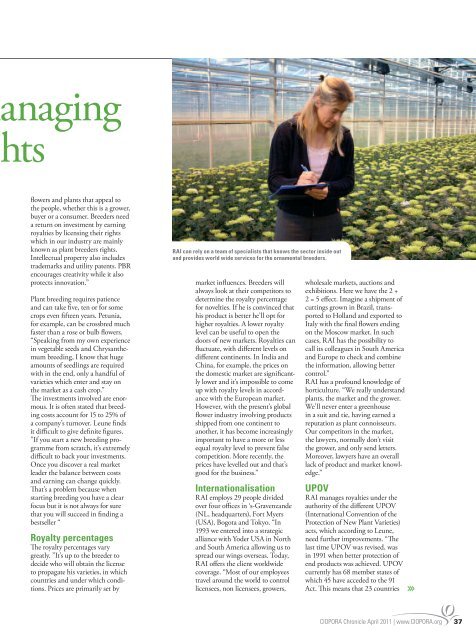2011 CIOPORA Chronicle - the 50th Anniversary Edition
CIOPORA annual magazine on Intellectual Property protection for plant innovations 2011. The magazine was produced in cooperation with FloraCulture International. Read in the 2011 CIOPORA Chronicle edition: - CIOPORA plays vital role in supporting the industry - PVR litigation on the rise - Plant Breeders´Right. Quo vadis? - China deploys national strategy for IPR - CIOPORA helps IP owners protect their rose varieties and much more...
CIOPORA annual magazine on Intellectual Property protection for plant innovations 2011. The magazine was produced in cooperation with FloraCulture International.
Read in the 2011 CIOPORA Chronicle edition:
- CIOPORA plays vital role in supporting the industry
- PVR litigation on the rise
- Plant Breeders´Right. Quo vadis?
- China deploys national strategy for IPR
- CIOPORA helps IP owners protect their rose varieties
and much more...
You also want an ePaper? Increase the reach of your titles
YUMPU automatically turns print PDFs into web optimized ePapers that Google loves.
naging<br />
hts<br />
flowers and plants that appeal to<br />
<strong>the</strong> people, whe<strong>the</strong>r this is a grower,<br />
buyer or a consumer. Breeders need<br />
a return on investment by earning<br />
royalties by licensing <strong>the</strong>ir rights<br />
which in our industry are mainly<br />
known as plant breeders rights.<br />
Intellectual property also includes<br />
trademarks and utility patents. PBR<br />
encourages creativity while it also<br />
protects innovation.”<br />
Plant breeding requires patience<br />
and can take five, ten or for some<br />
crops even fifteen years. Petunia,<br />
for example, can be crossbred much<br />
faster than a rose or bulb flowers.<br />
“Speaking from my own experience<br />
in vegetable seeds and Chrysan<strong>the</strong>mum<br />
breeding, I know that huge<br />
amounts of seedlings are required<br />
with in <strong>the</strong> end, only a handful of<br />
varieties which enter and stay on<br />
<strong>the</strong> market as a cash crop.”<br />
The investments involved are enormous.<br />
It is often stated that breeding<br />
costs account for 15 to 25% of<br />
a company’s turnover. Leune finds<br />
it difficult to give definite figures.<br />
”If you start a new breeding programme<br />
from scratch, it’s extremely<br />
difficult to back your investments.<br />
Once you discover a real market<br />
leader <strong>the</strong> balance between costs<br />
and earning can change quickly.<br />
That’s a problem because when<br />
starting breeding you have a clear<br />
focus but it is not always for sure<br />
that you will succeed in finding a<br />
bestseller “<br />
Royalty percentages<br />
The royalty percentages vary<br />
greatly. ”It’s up to <strong>the</strong> breeder to<br />
decide who will obtain <strong>the</strong> license<br />
to propagate his varieties, in which<br />
countries and under which conditions.<br />
Prices are primarily set by<br />
RAI can rely on a team of specialists that knows <strong>the</strong> sector inside out<br />
and provides world wide services for <strong>the</strong> ornamental breeders.<br />
market influences. Breeders will<br />
always look at <strong>the</strong>ir competitors to<br />
determine <strong>the</strong> royalty percentage<br />
for novelties. If he is convinced that<br />
his product is better he’ll opt for<br />
higher royalties. A lower royalty<br />
level can be useful to open <strong>the</strong><br />
doors of new markets. Royalties can<br />
fluctuate, with different levels on<br />
different continents. In India and<br />
China, for example, <strong>the</strong> prices on<br />
<strong>the</strong> domestic market are significantly<br />
lower and it’s impossible to come<br />
up with royalty levels in accordance<br />
with <strong>the</strong> European market.<br />
However, with <strong>the</strong> present’s global<br />
flower industry involving products<br />
shipped from one continent to<br />
ano<strong>the</strong>r, it has become increasingly<br />
important to have a more or less<br />
equal royalty level to prevent false<br />
competition. More recently, <strong>the</strong><br />
prices have levelled out and that’s<br />
good for <strong>the</strong> business.”<br />
Internationalisation<br />
RAI employs 29 people divided<br />
over four offices in ‘s-Gravenzande<br />
(NL, headquarters), Fort Myers<br />
(USA), Bogota and Tokyo. “In<br />
1993 we entered into a strategic<br />
alliance with Yoder USA in North<br />
and South America allowing us to<br />
spread our wings overseas. Today,<br />
RAI offers <strong>the</strong> client worldwide<br />
coverage. “Most of our employees<br />
travel around <strong>the</strong> world to control<br />
licensees, non licensees, growers,<br />
wholesale markets, auctions and<br />
exhibitions. Here we have <strong>the</strong> 2 +<br />
2 = 5 effect. Imagine a shipment of<br />
cuttings grown in Brazil, transported<br />
to Holland and exported to<br />
Italy with <strong>the</strong> final flowers ending<br />
on <strong>the</strong> Moscow market. In such<br />
cases, RAI has <strong>the</strong> possibility to<br />
call its colleagues in South America<br />
and Europe to check and combine<br />
<strong>the</strong> information, allowing better<br />
control.”<br />
RAI has a profound knowledge of<br />
horticulture. “We really understand<br />
plants, <strong>the</strong> market and <strong>the</strong> grower.<br />
We’ll never enter a greenhouse<br />
in a suit and tie, having earned a<br />
reputation as plant connoisseurs.<br />
Our competitors in <strong>the</strong> market,<br />
<strong>the</strong> lawyers, normally don’t visit<br />
<strong>the</strong> grower, and only send letters.<br />
Moreover, lawyers have an overall<br />
lack of product and market knowledge.”<br />
UPOV<br />
RAI manages royalties under <strong>the</strong><br />
authority of <strong>the</strong> different UPOV<br />
(International Convention of <strong>the</strong><br />
Protection of New Plant Varieties)<br />
acts, which according to Leune,<br />
need fur<strong>the</strong>r improvements. “The<br />
last time UPOV was revised, was<br />
in 1991 when better protection of<br />
end products was achieved. UPOV<br />
currently has 68 member states of<br />
which 45 have acceded to <strong>the</strong> 91<br />
Act. This means that 23 countries<br />
>>><br />
<strong>CIOPORA</strong> <strong>Chronicle</strong> April <strong>2011</strong> | www.<strong>CIOPORA</strong>.org 37









